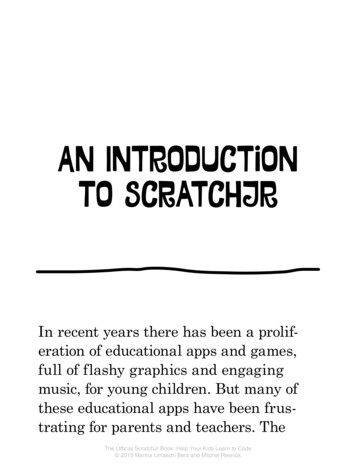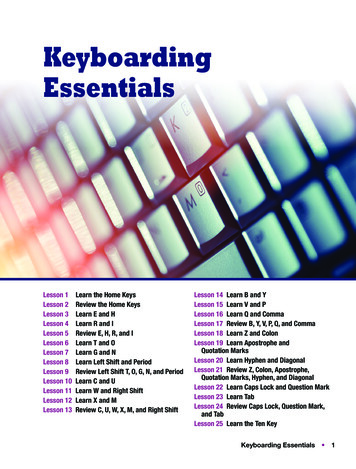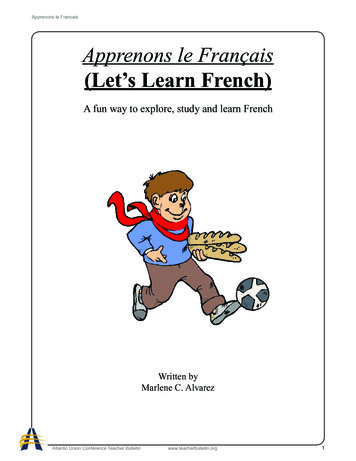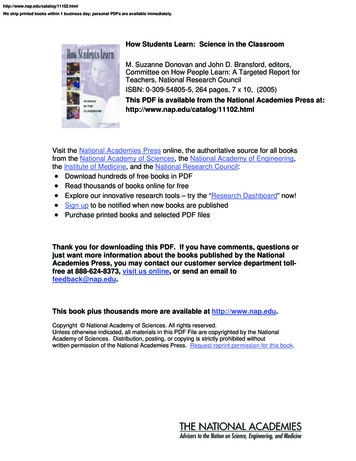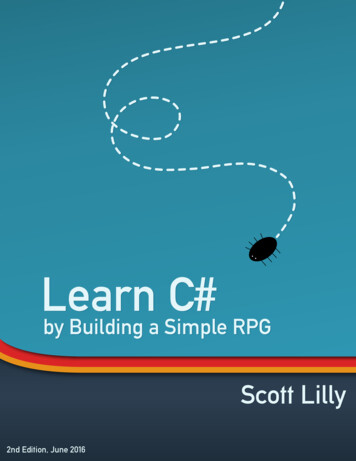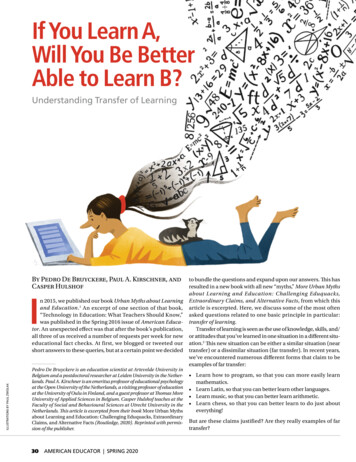
Transcription
If You Learn A,Will You Be BetterAble to Learn B?Understanding Transfer of LearningBy Pedro De Bruyckere, Paul A. Kirschner, andCasper HulshofIILLUSTRATIONS BY PAUL ZWOLAKn 2015, we published our book Urban Myths about Learningand Education. 1 An excerpt of one section of that book,“Technology in Education: What Teachers Should Know,”was published in the Spring 2016 issue of American Educator. An unexpected effect was that after the book’s publication,all three of us received a number of requests per week for neweducational fact checks. At first, we blogged or tweeted ourshort answers to these queries, but at a certain point we decidedPedro De Bruyckere is an education scientist at Artevelde University inBelgium and a postdoctoral researcher at Leiden University in the Netherlands. Paul A. Kirschner is an emeritus professor of educational psychologyat the Open University of the Netherlands, a visiting professor of educationat the University of Oulu in Finland, and a guest professor at Thomas MoreUniversity of Applied Sciences in Belgium. Casper Hulshof teaches at theFaculty of Social and Behavioural Sciences at Utrecht University in theNetherlands. This article is excerpted from their book More Urban Mythsabout Learning and Education: Challenging Eduquacks, ExtraordinaryClaims, and Alternative Facts (Routledge, 2020). Reprinted with permission of the publisher.30AMERICAN EDUCATOR SPRING 2020to bundle the questions and expand upon our answers. This hasresulted in a new book with all new “myths,” More Urban Mythsabout Learning and Education: Challenging Eduquacks,Extraordinary Claims, and Alternative Facts, from which thisarticle is excerpted. Here, we discuss some of the most oftenasked questions related to one basic principle in particular:transfer of learning.Transfer of learning is seen as the use of knowledge, skills, and/or attitudes that you’ve learned in one situation in a different situation.2 This new situation can be either a similar situation (neartransfer) or a dissimilar situation (far transfer). In recent years,we’ve encountered numerous different forms that claim to beexamples of far transfer: Learn how to program, so that you can more easily learnmathematics. Learn Latin, so that you can better learn other languages. Learn music, so that you can better learn arithmetic. Learn chess, so that you can better learn to do just abouteverything!But are these claims justified? Are they really examples of fartransfer?
Near versus Far TransferGeneral Character Traits and CreativityImagine that you’ve learned to drive. You quickly becomeaccustomed to your own car: how the gears work, where to findall the right buttons on the dashboard, etc. If you need to drivea rented car on vacation, some of these things may be different,but your past experience in your own car will soon help you toget the hang of things. It will even help you if you ever need tolearn how to drive a bus. This is what we mean by near transfer.3Many things from one situation are fairly similar to many thingsin the new situation, although there may be minor differenceshere and there.Far transfer was an idea first examined in 1923 by EdwardThorndike.4 It was Thorndike, for example, who discussed whetherlearning Latin could have a positive effect on logical thinking.Even in those days, it was apparent that this was not the case.According to him, it merely seemed that way because so many ofthe stronger students and thinkers were automatically encouraged to study Latin. In other words, it was more a question of acorrelation than a causal relationship. Consequently, the resultwas the product of something else, namely smarter students orstudents from a higher social-economic background.There is, however, another problem with the delineation of nearand far transfer. Perhaps you’ve come across the following situations in your own classroom. During a geography lesson, studentslearn how to read a map, but then have difficulty in reading a historical map during a history lesson—which, at first glance, youmight think should be an example of relatively near transfer. In acomparable way, mathematics is also used during physics lessons,but here the transfer is much easier to accomplish.To explain such situations, Thorndike formulated his theory ofidentical elements, which posits that near and far transfer can bestbe regarded as a continuum. Or to paraphrase his basic conclusion: transfer is easier in relation to the extent that there are moresimilar or identical elements between what has already beenlearned and what needs to be learned in the future. Accordingly,he argued that near transfer is, by definition, much easier than fartransfer.5 If we were to take the precepts of this “old” theory at facevalue, the outlook for the advocates of far transfer might be fairlypessimistic. But is this really the case? Let’s take a closer look at anumber of examples.Creativity is not a skill, and it cannot be taught or learned. Creativity is a quality or characteristic that a person possesses. In otherwords, it’s a trait and not a state. Researcher Charles Reigeluthexplains it as follows: “Traits are student characteristics that arerelatively constant over time, whereas states are student characteristics that tend to vary during individual learning experiences, such as level of content-specific knowledge.”7 Viewed inthese terms, it’s not simply that creativity can’t be learned; it’s alsovery difficult to influence. All that teachers can do is to provide alearning climate that offers psychological safety—a climate inwhich learners feel sufficiently secure—so that they have the courage and the confidence to do things and say things that, at firstglance, perhaps seem odd or not completely right. In other words,teachers can provide an environment that encourages studentsto take risks, safe in the knowledge that their mistakes will be tolerated with understanding. We call this psychological safety.Is Chess the Key to Success at School and in Life?In 2011, chess became a compulsory subject in Armenian schools.Armenian authorities were convinced that chess is the key to success at school and in life. By making chess mandatory, they hopedto teach children how to think creatively and strategically. As aresult, they will become more intelligent and be better able tosolve problems. What’s more, this does not just mean chess problems, but all problems in all other school subjects, as well as inlater life. If true, this is extremely far transfer. There are indeedresearch studies that demonstrate a link between chess masteryand improved cognitive skills and work performance.6In essence, what the Armenian Ministry of Education was saying is that learning how to play chess not only is the key to developing general skills (in particular, problem solving), but also hasa crucial impact on general character traits, such as emotionalstability, intellect, memory, alertness, and, above all, creativity.Transfer of learning is seen asthe use of knowledge, skills,and/or attitudes that you’velearned in one situation in adifferent situation.Memory is also a trait, so it, too, cannot be learned. This doesnot mean that it cannot be trained or improved, but such trainingneeds to be highly focused and demands a huge investment intime. Consequently, this is not something that can be achieved“en passant” simply by learning to play chess.If we look at this in the context of the Armenian claims aboutchess and creativity, a chess teacher who provides a psychologically safe climate may indeed be able to teach one or morechildren how to play chess creatively, but the basic startingpoint is that the child must possess both the necessary chessknowledge (moves, tactics, strategies) andthe necessary chess skills (by using thatMore Urban Myths about Learning andEducation: Challenging Eduquacks,Extraordinary Claims, and AlternativeFacts by Pedro De Bruyckere, Paul A.Kirschner, and Casper Hulshof is published by Routledge, which is offering a20 percent discount off the purchase ofthe book. To order, visit www.routledge.com/9780815354581, and use discountcode A043 (cannot be used in conjunction with any other offer or discount).AMERICAN EDUCATOR SPRING 202031
knowledge repeatedly in practice games and competitions).This has been known since 1946, when Adriaan de Groot wrotehis famous doctoral thesis, Het denken van den schaker (Thoughtand Choice in Chess).8In our previous book, we discussed the work of Sir Ken Robinson and formulated a number of reservations about his rathernarrow definition of creativity (in his book Creative Schools: TheGrassroots Revolution That’s Transforming Education), but eventhis narrow definition is applicable in this present context.According to Robinson, creativity is “the process of having originalideas that have value.” The key word here is “value.”Without knowledge and skills, it’s impossible—except by sheerluck—to create something of value. In fact, if you don’t have therequisite knowledge, you are not even in a position to assess thevalue of what you have done. If you don’t know how to play chess,just see how far you get if you are ever asked to develop a creativeand valuable solution to a chess problem!The Effect of Learning to Play Chess on Other SkillsThe ability (or otherwise) to change personality traits is still amatter of much discussion, but does chess perhaps have a positive influence on other disciplines and areas of study? This is asubject that has been intensively researched over the years.Some of the resultant studies do indeed suggest a positive effect,9whereas others have reached very different conclusions. To helpclarify this situation (if we can), it’s useful to look at the reviewsof the various studies, also bearing in mind the quality of theresearch methodology used.One review on the subject of chess and education came witha painful conclusion: “Research in psychology and educationsuggests that cognitive skills acquired in one domain are not easilytransferred to another domain. Do the empirical results of chessresearch undermine this contention? Unfortunately, the answeris: no.”10 In other words, chess is not an exception to Thorndike’stheory of identical elements. A more recent review also found verylittle real evidence for transfer, although the researchers’ finalassessment was somewhat milder.11 They concluded that the testresults show that learning to play chess can sometimes have apositive effect on student learning, but this is confined to arithmetic/mathematics in primary and secondary education.Moreover, this positive effect is only for the short term; thereis nothing to suggest more long-term, permanent benefits. Andthere is more bad news. They further concluded that there is acorrelation between the quality of the research design and thelevel of the effect identified: the better the design, the smaller theeffect. In fact, the most rigorous studies found almost no positiveeffect whatsoever.12Finally, mention should also be made of a large-scale metaanalysis conducted in 2016 that investigated the possible linkbetween intelligence and chess.13 The conclusion could not beclearer: intelligent players play better chess. This causality followsthe same direction that Thorndike established with regard to Latin.Does Learning How to Program a ComputerEncourage Problem-Solving Thinking?Steve Jobs once said: “Everybody in this country should learn howto program a computer, should learn a computer language,because it teaches you how to think.”14 But was the Apple boss32AMERICAN EDUCATOR SPRING 2020right? You might be excused for initially thinking that this is anarea where very little research has been carried out, so that it’sdifficult to reach firm conclusions. And you would be right—upto a point. After all, it’s only recently that a teaching module forprogramming was introduced in the United Kingdom, and computers like the BBC micro:bit, the Arduino, and the Raspberry Piare all relatively new in education. That being said, in reality, thesedevelopments are merely the latest wave in the process of “programming in education,” which actually stretches back over anumber of decades and has repeatedly investigated the basic ideathat Jobs reformulated. Consider, for example, Logo, the program-Without knowledge andskills, it’s impossible—except by sheer luck—to create somethingof value.ming language developed for education as long ago as 1967 bySeymour Papert, with its characteristic “turtles.” These turtlerobots were first invented in the late 1940s by, among others, William Grey Walter,15 but only became widely known in educationalcircles thanks to Papert, who used them as a means to promoteLogo as a programming language for schools, with the specificaim of stimulating problem-solving capabilities.16The oldest research into such matters was conducted by Richard Mayer and dates from 1975. His work suggested that learninghow to program could have a positive effect on problem-solvingthinking, although in reality his study focused more on the bestway to effectively teach programming.17In contrast, a series of subsequent studies generally concludedthat there is no such positive effect. A 1990 study based on a randomized controlled trial found no link between programming andthe ability to solve problems.18 This was also the conclusion of acomparable study by Mayer.19 Other research suggested that programming might have a limited beneficial effect on divergentthinking, but this cannot be taken as evidence that it has a majorbeneficial effect on problem-solving capabilities.20That being said, a review study carried out in 1985 that specifically looked at Logo and its effect on other domains added animportant nuance. Just teaching students how to program withLogo had little or no effect. However, if teachers used Logo forspecific tasks with a specific purpose, such as mathematics orproblem-solving thinking, a “moderate” effect could be achieved.But the input of the teacher was crucial to generate this effect; theprogramming itself played only a marginal role.21Similar conclusions were reached in a 1990 research project.The researchers found evidence of a clear benefit for problemsolving thinking as a result of learning how to program. Once
again, however, there was an important “but”: their researchfocused on students in further education who all wanted to learnprogramming. Moreover, there was no control group.22 Much thesame applies to another study that found a positive effect but alsoconcluded that simply teaching students how to program is notenough to generate this effect.23 The only effective way that thelearning of programming can stimulate problem-solving capabilities is for the teacher to give a clear focus on using those skills ina problem-solving context. And once again, there was no controlgroup to compare, for example, the results of attempts to deal withthe same problem-solving content without the benefits of programming skills.It would be possible to carry on like this for quite some time,but we have probably already quoted enough research to makeour point: perhaps the problem is not the teaching of programming; the problem is the idea that it’s possible to teach studentshow to think in a problem-solving manner. Or, as researchersconcluded in 2010:In over a half century, no systematic body of evidence demonstrating the effectiveness of any general problem-solvingstrategies has emerged. . There is no body of research basedon randomized, controlled experiments indicating that suchteaching leads to better problem solving.24Does Music Help You PerformBetter in School in General?Since all three of us are music lovers, we need to be wary of possible confirmation bias when it comes to this particular subject:it’s sometimes all too easy to search for evidence that confirmswhat you would like to be true! That being said, a very recentlongitudinal study (i.e., a study that follows the same people fora number of years, here also using a randomized design with acontrol group) gives some grounds for optimism.25More specifically, Artur Jaschke and his colleagues examinedthe effects of learning how to play music on executive functions,the higher cognitive processes that are necessary to plan anddirect activities. Over the duration of the study, the scores periodically given to the intervention group for impulse suppression(inhibition), planning, and verbal intelligence all improved significantly. It’s also possible that the improvements in these threequalities helped account for a similar improvement in generalschool results. The idea that music can have a positive effect onexecutive functions is nothing new,26 although it’s still far fromclear how long this effect lasts.27 The Jaschke study attempted toavoid the limitations and shortcomings of many previous studies.Consequently, there is hope that its conclusions will prove morereliable. And this hope is necessary because, in contrast, a previous meta-analysis found no evidence of far transfer as a result oflearning how to play music.28 Yes, it concluded that musicians areindeed often more intelligent than others (we love you, yeah, yeah,yeah), but this is more a correlation than anything else. As far asa possible causal link is concerned, in most studies this is negatively reflected in the quality of the study itself. The better theresearch, the smaller the link.But is it actually a good thing to search for far transfer in relation to music? This is the question that the Organization forEconomic Cooperation and Development (OECD) asked in itsown review of the influence of art education in general andmusic education in particular.29 By asking what value music hasfor improving performance in other disciplines, there is a riskthat this effectively devalues music’s worth as a discipline in itsown right. This is a fair point: much far transfer thinking is basedon the utility principle that makes one discipline subordinate toanother. In wider cultural and educational terms, chess is lessimportant than music. But perhaps chess also has the potentialto make students better at something else. And perhaps it cando this more effectively than music. What then would be thefuture of music as an academic subject?And it doesn’t just have to be chess. Imagine that somethingelse comes along—the use of classroom rituals, for example—that is proven to have a more significant impact on improvedexecutive functions than music.30 If music is regarded purely asa means to an end rather than as an end in itself, this might evenlead to its removal from the curriculum! It’s surprising that thisissue should be raised by an economic organization like theOECD, but it’s important that someone raises it. In art education,the desire for possible far transfer must remain subordinate tothe wider cultural value of artistic disciplines—and not the otherway around.Does Learning Latin Help You toLearn Other Languages Better?Apart from a huge fortune in the bank, what do Harry Potterauthor J. K. Rowling and Facebook guru Mark Zuckerberg havein common? They both learned Latin in school.31 Various universities still use Latin names to add a certain cachet to the studyof classics and classical languages. It is as though they seem tosay that knowledge of Latin is the secret to success!While in many countries (foreign) language education hasgiven way to education based on the so-called STEM subjects(science, technology, engineering, and mathematics), in theNetherlands and Belgium, Latin is still an important part of thecurriculum.32 For centuries, Latin was the language of knowledgeand erudition, and, consequently, also the language of the elite,as it was also an important key to the door that led to university.It was only when education became more readily accessible atthe start of the 20th century, and when Latin gradually disappeared as the language of science and learning, that argumentsfor its teaching began to change. Latin was now seen as beingimportant for the general education of students, which waseffectively the same as saying that Latin was a good way to teachAMERICAN EDUCATOR SPRING 202033
students how to think. As a subsidiary argument, it was also suggested that learning Latin made it easier to learn other languages, such as French, Spanish, and/or Italian.33But is this true? Does learning Latin teach you anything morethan just Latin? During the past century, research has focusedprimarily on this second argument: Latin as a linguistic facilitator. A review study34 found evidence supporting a weaker formof this argument, namely that learning Latin helped Americanchildren first and foremost learn their own language better.Unfortunately, many of the studies in this field lack reliability asa result of serious methodological shortcomings or due to afailure to properly check out all relevant related factors, such asthe socioeconomic background of the students (see also Thorndike’s conclusions on this matter). One small study that is bothrelevant and reliable monitored a group of German childrenlearning Spanish. Some of the children also received lessons inLatin, others in French. The results showed that the childrenbenefited more from first learning French, rather than Latin,before Spanish. In fact, the students who learned Latin mademore grammatical errors in Spanish than those who had learnedFrench.35 Once again, Thorndike’s identical elements theorywould seem to hold.As far as the second question is concerned—can learningLatin help you to think better?—very little meaningful researchhas been conducted, largely because it’s so difficult to definewhat we mean by “thinking” to everyone’s satisfaction. Be thatas it may, one study36 concluded that there was no relationshipbetween the skills needed to learn Latin and the skills neededto learn other languages or mathematics. But that is more orless as far as the research goes at this stage. In other words,there is nothing to suggest a link between “learning Latin” and“better thinking.”If it’s unlikely that Latin makes it possible to learn other languages more easily, and if Thorndike’s theory suggests that fartransfer is equally improbable, we can then reasonably ask thesame question that we asked of music: Should Latin still betaught because of any intrinsic value of its own? Up to a point,the answer is yes. There are indications that learning Latin canlead to greater self-confidence and a deeper appreciation forother cultures,37 although this can just as easily be said for manyother foreign languages, such as Chinese.The British classicist Mary Beard offers a more specific reasonfor learning Latin: it gives young people access to the literarytradition that forms the basis of Western culture.38 Again, thismight well be the case, but it’s open to discussion as to whetherthat argument alone is sufficient to merit including Latin in thecurriculum. In fact, all the “old” arguments in favor of Latin—that it has specific characteristics that make it easier to learnother languages and also improves a student’s general ability tothink—no longer seem relevant or credible in this modern dayand age.In this article, we investigated four popular examples of claimsfor far transfer, but in each case the results were disappointing. This is not to say that there is no evidence whatsoever forfar transfer, but it’s very clear that the level of reliable evidence decreases in relation to the quality of the research: thebetter the research, the scanter the evidence.One insight—in fact, a slight irritation—that came to lightduring our investigation and writing is that Thorndike’s theory—devised more than 100 years ago—still seems applicable.Throughout the past century, repeated efforts have been madeto contradict his claim that the greater the number of identicalelements, the greater the likelihood of far transfer. To date, noone has really succeeded, us included. Even so, it remains clearthat far transfer is not the magic remedy for cross-disciplinelearning that many in education once hoped it would be. Endnotes1. See P. De Bruyckere, P. A. Kirschner, and C. D. Hulshof, Urban Myths about Learning andEducation (San Diego, CA: Academic Press, 2015).2. D. N. Perkins and G. Salomon, “Transfer of Learning,” in International Encyclopedia ofEducation, 2nd ed., ed. T. Husen and T. N. Postlethwaite (Oxford: Pergamon Press, 1992),6452–6457. Mention is made of transfer or training, whereby the skills trained for in one domainhave a positive effect in another domain.3. Perkins and Salomon, “Transfer of Learning.” Near transfer and far transfer have meantdifferent things at different times. For example, J. M. Royer described the terms as follows: “I willuse the term near transfer to refer to instances in which one classroom learned skill, or bit ofknowledge, transfers to another classroom skill or bit of knowledge. I will use the term fartransfer to refer to situations in which material learned in the classroom transfers to events orproblems encountered outside of the classroom.” See J. M. Royer, “Theories of the Transfer ofLearning,” Educational Psychologist 14, no. 1 (1979): 53–69.4. E. L. Thorndike, “The Influence of First Year Latin upon the Ability to Read English,” SchoolSociology 17 (1923): 165–168.5. R. S. Woodworth and E. L. Thorndike, “The Influence of Improvement in One Mental Functionupon the Efficiency of Other Functions,” Psychological Review 8, no. 3 (1901): 247.6. See, among others, I. J. Deary et al., “Intelligence and Educational Achievement,” Intelligence35 (2007): 548–555; and J. E. Hunter and R. F. Hunter, “Validity and Utility of AlternativePredictors of Job Performance,” Psychological Bulletin 96 (1984): 72–98.7. C. M. Reigegluth, ed., Instructional-Design Theories and Models: An Overview of Their CurrentStatus (Hillsdale, NJ: Erlbaum Associates, 1983).8. A. D. de Groot, Het denken van den schaker (Amsterdam: Noord-Hoolandsche UitgeversMaatschappij, 1946).9. There are two Armenian reports mentioning positive effects: R. Aghuzumtsyan and S.Poghosyan, “The Impact of Chess Lessons on Formation and Development of the Students,”International Conference Chess in Schools (Yerevan: Zartprint, 2014), 87–97; and R. Mirzakhanyana et al., “Analysis of the Efficiency of Teaching Chess in Schools,” Sociology 7, no. 1 (2017):36–42. The first study shows correlations; the second illustrates how context plays a role.10. F. Gobet and G. Campitelli, “Educational Benefits of Chess Instruction: A Critical Review,” inChess and Education: Selected Essays from the Koltanowski Conference, ed. T. Redman (Dallas:Chess Program at the University of Texas at Dallas, 2006), 139.11. G. Sala, J. P. Foley, and F. Gobet, “The Effects of Chess Instruction on Pupils’ Cognitive andAcademic Skills: State of the Art and Theoretical Challenges,” Frontiers in Psychology 8 (2017):238.12. G. Sala and F. Gobet, “Does Far Transfer Exist? Negative Evidence from Chess, Music, andWorking Memory Training,” Current Directions in Psychological Science 26 (2017): 515–520.13. A. P. Burgoyne et al., “The Relationship between Cognitive Ability and Chess Skill: AComprehensive Meta-Analysis,” Intelligence 59 (2016): 72–83.14. “Steve Jobs Says Everyone Should Learn to Program,” YouTube video, posted by Scott Moss,July 5, 2012.15. M. J. Mataric, The Robotic Primer (Cambridge, MA: MIT Press, 2007).16. S. Papert, Mindstorms: Children, Computers, and Powerful Ideas (New York: Basic Books,1980).17. R. E. Mayer, “Different Problem-Solving Competencies Established in Learning Computer(Continued on page 40)34AMERICAN EDUCATOR SPRING 2020
More Than a Warm WelcomeELLs on the CuspInterleaving in Math(Continued from page 8)(Continued from page 22)(Continued from page 28)enabled them to overcome so much insearch of a better future for their families.When asked about her hopes for her children, Adelah Saleh shares two, the first ofwhich is fairly modest. She’d like to see themtake more field trips in school—perhaps toa science museum or to the state capital,Lansing. But she also has somethinggreater in mind. “I want them to be successful in life, to finish their education,and to spread peace,” she says in Arabic,as Hamade, the family liaison, translatesinto English. “We came from a countrywith no peace. This is what we miss, andthis is what we wanted.” 23. Robinson, “Evaluating Criteria.”8. D. Rohrer et al., “A Randomized Controlled Trial ofInterleaved Mathematics Practice,” Journal of EducationalPsychology, advance online publication, http://dx.doi.org/10.1037/edu0000367.Transfer of LearningProgramming: Multiple Research Perspectives, ed. R. E. Mayer(Hillsdale, NJ: Lawrence Erlbaum Associates, 1988), 111–135.(Continued from page 34)24. J. Sweller, R. Clark, and P. Kirschner, “Teaching GeneralProblem-Solving Skills Is Not a Substitute for, or a ViableAddition to, Teaching Mathematics,” Notices of the AmericanMathematical Society 57 (2010): 1303–1304.Programming with and without Meaningful Models,” Journalof Educational Psychology 67, no. 6 (1975): 725–734.18. C. A. VanLengen and C. D. Maddux, “Does Instruction inComputer Programming Improve Problem Solving Ability,”Journal of Information Systems Education 2, no. 2 (1990):11–16.Sign up at www.Aft.org/signupto receivethe “DifferentAft’sProblem-Solvingmonthlye-news19. Mayer,Competencies.”20. D. H. Clements and D. F. Gullo, “Effects of ComputerProgramming on Young Children’s Cognition,” Journal ofEducational Psychology 76 (1984): 1051–1058.for professional development21. D. Clements, “Research on Logo in Education: Is the TurtleSlow but Steady, or Not Even in the Race?,” Computers in theSchools 2, no. 2–3 (1985): 55–71.resources, news, and digitalactions to show that you,22. J. J. Tu and J. R. Johnson, “Can Computer ProgrammingImprove Problem-Solving Ability?,” ACM SIGCSE Bulletin 22,no. 2 (1990): 30–33.too, are stickingwithyour union.23. J. Littlefield et al., “Learning LOGO: Method of Teaching,Transfer of General S
learn how to read a map, but then have difficulty in reading a his-torical map during a history lesson—which, at first glance, you might think should be an example of relatively near transfer. In a comparable way, mathematics is also used during physics les




